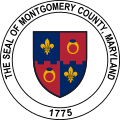 The current flag of Maryland's Montgomery County. | |
| Use | Other |
|---|---|
| Proportion | 2:3 |
| Adopted | October 5, 1976 [1] |
| Design | A rectangle, three parts wide and two parts tall, quartered by a crenellated line, separating the top two quarters from the two bottom quarters, and a straight vertical line, separating the left two quarters from the two right quarters, with the upper left and lower right quarters consisting of a gold fleur-de-lis on a blue background, with the upper right and lower left quarters consisting of a gold ring with a blue gem on a red background, with a crenellated line formed of 11 squares, 1/11 of flag length, with center block split in middle with left side red and right side blue, with rings and fleur-de-lises to be three times as high as a block in the crenellated line with width proportional, with rings and fleur-de-lises centered horizontally on their quarters and spaced vertically so that upper and lower edge of rings and fleur-de-lises at equal distance from the horizontal outside edge of quarter and nearest part of crenellated line. [1] |
| Designed by | College of Arms |
 | |
| Use | Other |
| Adopted | May 3, 1944 – October 5, 1976 [2] [3] |
| Designed by | Lilly Catherine Stone [2] [3] |
The current flag of Montgomery County, Maryland was adopted on October 5, 1976. It was designed by the British College of Arms. [1] It is commonly flown outside of the Montgomery County's governmental facilities, such as fire stations.
Contents
- History
- Former flag: 1944–1976
- Current flag: 1976–present
- Design
- Colors
- See also
- References
- External links
The flag is based on the coat of arms of the Montgomery family, a scion of which, Richard Montgomery, gave the county its name. [1] It is the county's second flag, replacing the first one, which had been in use from May 3, 1944, until its replacement in 1976. [2] [3]



